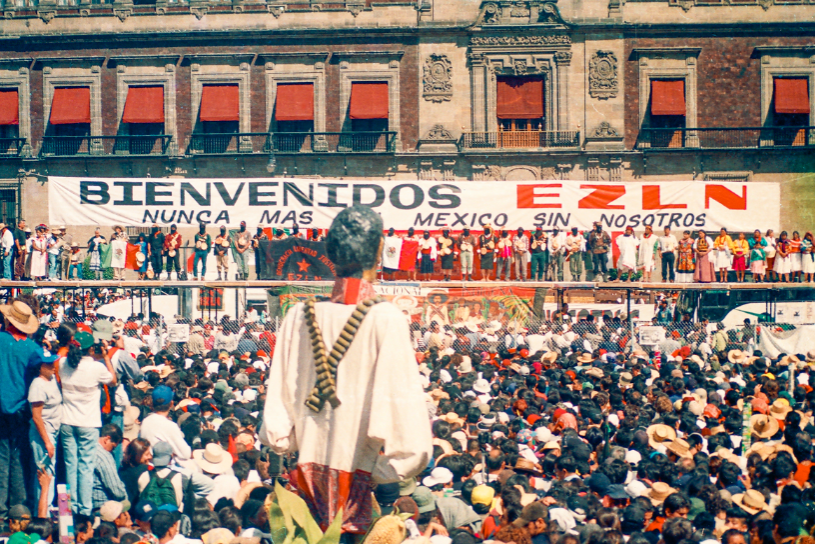
Text: Luis Hernandez Navarro
Featured Photo: Luis Suaste of Regeneration Radio
It’s been 20 years since the March of the Color of the Earth, the Zapatista journey across 12 states that shook deep Mexico. Between the 24th of February and the 28th of March 2001, 24 rebels travelled 3 thousand kilometers of highway, filled plazas along the way and placed in the center of the political debate a radical dilemma: build a country for all or a nation for a few.
The mobilization began with the new moon. Its fragrance was that of the great marches of Martin Luther King for the rights of African Americans in the 60’s, of the indigenous uprisings in Ecuador, or the days of Indian struggle in Bolivia. Born of an extreme situation in the farthest corners of the world, these protests climbed up and down mountains to carry their word and presence to the political heart of their nations.
The march was part of a series of mobilizations of the Zapatista Army of National Liberation (EZLN) outside of Chiapas, initiated in october of 1996 with the departure of Comandanta Ramona, and the founding of the National Indigenous Congress (CNI), the caravan of the the 1, 111 to Mexico City in September of 1997, and the consultation in March of 1999.
At the beginning, more than 20 thousand EZLN bases of support peacefully occupied the streets of San Cristóbal de las Casas, Chiapas, to send off their delegates. As of that moment, city after city, town after town, the demonstrations of popular support intensified to the point of overflowing in the culminating rally in the Zócalo of Mexico City on the 11th of March.
The explicit objective of that day was to meet with the Congress of the Union to dialogue about the initiative of constitutional reforms on indigenous rights and culture elaborated by Cocopa1.
The EZLN announced the march one day after the inauguration of Vincente Fox. Outside of the palace disputes, the mobilization became the primary challenge to his conservative Revolution, with hundreds of thousands of people in the streets and mass media coverage. To the dread of the businessmen, that went to the extreme of recommending locking oneself in their houses, it managed to get the urban and rural poor to join the indigenous cause with warm enthusiasm.
The expedition awoke an unstoppable wave of indigenous support. February 27th in Tehuacán, Puebla, Concepción Hernández Méndez, the people’s lawyer and tireless fighter for human rights, told the rebel delegates, deliberately as if she were reciting an ancestral poem, that she was making this expedition for indigenous dignity her own. “We live it as our own,” she said “because within it is the seed that today we want to begin to germinate. Your heart is in our Indian word. Your reason for being is in our rights. In your achievements and objectives, we place our hope. In this march are the possibilities that we reach a tomorrow full of hope. This is the hour of Indian peoples.”
The 11th of March, already in Mexico City, the Zapatistas moved from Xochimilco to the Zócalo aboard a Kenworth truck with the EZLN on the cab and the bed uncovered. An enormous banner on its side read: Never Again A Mexico Without Us! Throughout the 16 kilometers march, tens of thousands of people came out into the streets, balconies and rooftops to cheer them. It was a historical march, Eduardo Galeano wrote. Emiliano Zapata entered Mexico City for the second time, he said.
In a memorable speech, Subcomandante Marcos resumed, “On this trip, we indigenous have seen the map of a national tragedy, from Chiapas to this Zócalo at the center of power, and we have been gaining a flower of brown dignity. He added: This is the hour of the Indian peoples, of the color of the earth, of all of the colors that we are underneath and the colors we are in spite of the color of money.”
Finally, in a historical act, on the 28th of March, the Zapatista and the CNI spoke in the court of San Lázaro. “It is also a symbol that I, as a poor woman, indigenous and Zapatista, have the first word, and that mine is the central message of our word as Zapatistas,” expressed Comandanta Esther. She added that the country that the rebels want is one “where difference is recognized and respected. Where the being and thinking differently is not a reason to go to jail, to be persecuted or to die.”
Despite the enormous mobilization, instead of settling the Mexican state’s historic debt with the indigenous peoples, the Congress of the Union raised it, by legislating a caricature of constitutional reform on indigenous rights and culture. It bet on a country for the few. One cannot understand the Mexico of today apart from this betrayal. At that time a chasm opened between the political class and the Indian peoples that continues to this day.
The March of the Color of the Earth had behind it long-standing roots and reasons. Different from other protests, those born of demands for recognition and dignity of the indigenous peoples are far from fleeting episodes. Zapatismo survived the crime of the parties. True to the peoples that gave it life, it was remade on the path to autonomy without asking permission. As it did 20 years ago, now it prepares for another journey heading for hope, but with a distinct arrival station: Europe from below.
This article was published in La Jornada on March 16th, 2021. https://www.jornada.com.mx/2021/03/16/opinion/012a2pol This English interpretation has been published by Schools for Chiapas.
